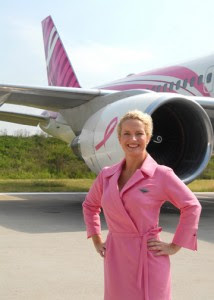
The Russian airline Aeroflot confirmed today that a Boeing 737-500 aircraft operated by Russian domestic regional carrier, Aeroflot-Nord, crashed at Perm in eastern Russia. The accident occurred on September 14, 2008 at approximately 5:10 a.m. local time as Aeroflot Flight SU-821, which had originated at Moscow's Sheremetyevo Airport, was on approach to Perm. The aircraft (Bermuda registration number VP-BKO) was destroyed, and there were no survivors among the 82 passengers and six crew members on board. The crew members who perished were based at Archangelsk.
A
message posted on the Aeroflot website said, in part, "Radio contact with flight SU821 was lost at 1,100 metres as the plane was descending for its landing at Perm; at the same time the plane’s signal was lost on air traffic controllers’ displays. Wreckage of the plane has been found within the boundaries of the city of Perm. The plane was totally destroyed and had caught fire."
Several news reports say that the accident happened as the aircraft was attempting to land at Perm for the second time, after a go-around. Some media reports said that at least one of the aircraft's engines may have been on fire, according to witnesses, but this has not been confirmed.
[Note: According to investigators, there was no engine fire prior to the crash. See Sep. 18, 2008 update below.] The aircraft was equipped with CFM56 engines. Russian officials quoted by the news media said that both the Cockpit Voice Recorder (CVR) and the Flight Data Recorder (FDR) had been recovered from the wreckage.
The aircraft crashed on or near the tracks of the
Trans-Siberian Railway, causing railroad service to be temporarily suspended. No one on the ground was said to be injured.
A
list of the names of the Aeroflot Flight SU-821 passengers and crew has been posted on the Aeroflot website (Russian language). Names of the six crew members are as follows:
- Командир - Медведев Родион Михайлович
- 2-ой пилот - Аллабердин Рустам Рафаилович
- Широкова А.Д.
- Норицина Т.В.
- Яковлева А.Ю.
- Кучма О.В.
Condolences to the family, colleagues and friends of those who lost their lives in this accident.
UPDATE Sep. 15, 2008: Flight International, quoting officials of Russia's Interstate Aviation Committee (MAK), is
reporting that both the cockpit voice recorder and the flight data recorder from the Aeroflot-Nord B737 accident at Perm have been badly damaged. MAK officials said that, given the damage, decoding the data will require "additional work using special equipment."
According to today's
Flight International article, MAK says the investigative commission will include US and French participants, representing the manufacturing states of the airframe and engines. A representative from the UK will also take part because the aircraft was Bermuda-registered.
UPDATE Sep. 18, 2008: New information posted today on the website of Russia's Interstate Aviation Committee (MAK) about the Aeroflot-Nord B737 accident says that both of the aircraft's engines were operating normally prior to the crash, neither engine was on fire, and the aircraft did not break up before impact. This determination was made through examination of fragments of aircraft engines at the scene, and interpretation of data obtained from the aircraft's Flight Data Recorder (FDR) and Cockpit Voice Recorder (CVR).
You can follow the progress of the investigation on
this page of the MAK website (Russian language). If you cannot read Russian, I suggest using
Google Translate for assistance.
[Photo Source]
 In anticipation of a strike by three labor unions, Japan Airlines (JAL) has announced the cancellation of nearly a quarter of its domestic passenger flights for tomorrow, October 1, 2008. The strike, which is in response to a wage dispute, will affect about 14,000 passengers as JAL expects to cancel 152 flights within Japan.
In anticipation of a strike by three labor unions, Japan Airlines (JAL) has announced the cancellation of nearly a quarter of its domestic passenger flights for tomorrow, October 1, 2008. The strike, which is in response to a wage dispute, will affect about 14,000 passengers as JAL expects to cancel 152 flights within Japan.


























